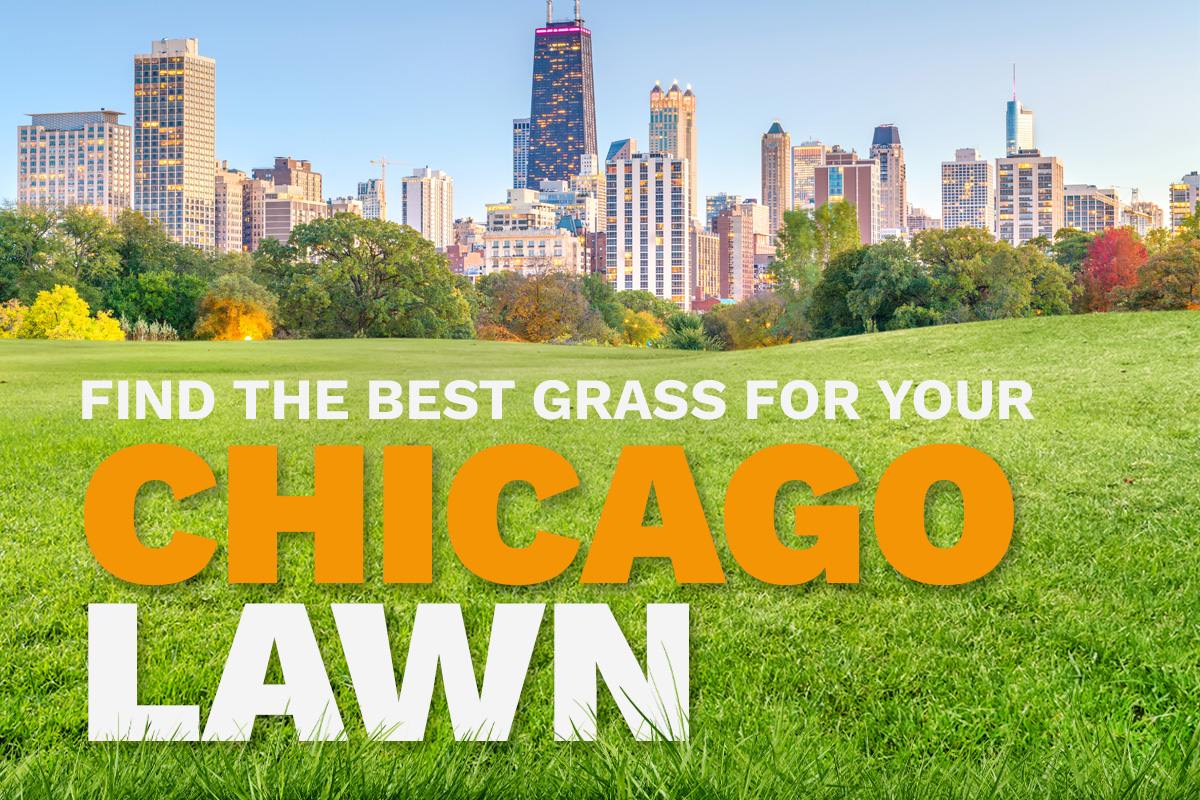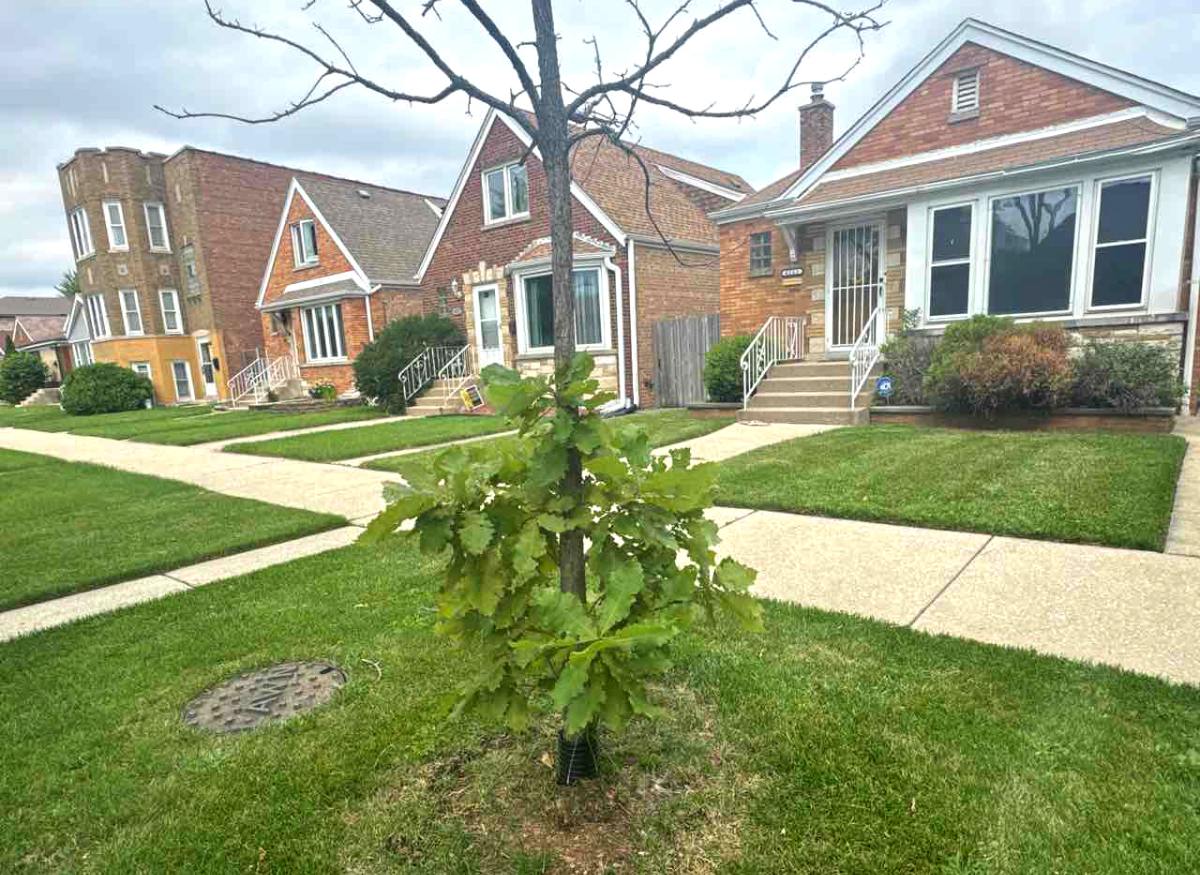
The best grass types for the Chicago area can take our cold winters and hot summers, occasional drought, and sometimes, too much rain.
That means the best grass types for Chicagoland lawns are Kentucky bluegrass, turf-type tall fescue, fine fescues, and perennial ryegrass.
Calculate the Best Grass for Your Chicago Lawn

But which of these 4 cool-season grasses is best for your particular lawn? The best grass for you really depends on how much time you plan to spend caring for your Chicago lawn. Answer a few questions, such as how much lawn maintenance you want to do, and our Grass Match tool will calculate which is the best grass type for you and your lawn.
🌱 Grass Match Calculator for Chicago
Find the perfect grass type for your Chicagoland lawn
1. Kentucky Bluegrass

Kentucky bluegrass is the most common grass in Chicago and across the area, including Naperville and Matteson. Kentucky blue is probably the most well-known and popular cool-season grass for northern climates.
One of the advantages of this blue-green, fine-textured grass is that it spreads by rhizomes, which means it can fill in if a patch dies.
Kentucky bluegrass also manages drought by going dormant. When it rains again, the grass greens up.
It’s really a sun-loving grass and does not do well in heavy shade.
Note: Kentucky bluegrass seed does not germinate well, so it’s usually mixed with other species like perennial rye to ensure good coverage.
- Shade Tolerance: Low to moderate
- Drought Tolerance: Moderate
- Foot Traffic Tolerance: Low to moderate (rhizomes help it recover)
- Maintenance Needs: High
- Potential for Disease: Moderate; susceptible to several fungal diseases, including necrotic ring spot and summer patch
LawnStarter Chicago Pro Tip: For spring, summer, fall, or winter care, two helpful tips are:
- 1. Aerate your lawn in the fall or early spring to improve soil health.
- 2. Adjust your mowing height throughout the year, keeping it taller in the summer to retain moisture and prevent weed growth.
See Related:
– Guide for Growing Kentucky Bluegrass
– When to Fertilize Kentucky Bluegrass
2. Turf-Type Tall Fescue

Turf-type tall fescue used to be called tall fescue, and it had a rough, weedy texture. Genetics has greatly improved this species, and now it has a dark green color and a coarse texture like Kentucky bluegrass.
This fescue is a clump or bunch grower but develops an extensive root system. The root system reduces watering needs, so an irrigation system may need to be adjusted.
Although shade-tolerant, turf-type tall fescue needs at least 4 hours of direct sun each day. This means this grass is suitable for Elmhurst, Glencoe, and other sunny Chicago-area lawns.
- Shade Tolerance: Moderate
- Drought Tolerance: High
- Foot Traffic Tolerance: High (but doesn’t recover well and will require overseeding)
- Maintenance Needs: Low (but requires frequent mowing)
- Potential for Disease: Low; susceptible to brown patch
See Related:
– Tall Fescue Lawn Maintenance Guide
– When to Fertilize Fescues
3. Fine Fescues

Fine fescues are a group of low-maintenance grasses: creeping red fescue, chewings fescue, hard fescue, and sheep fescue.
Fine fescues are medium to dark green in color with a fine, feathery texture. Fine fescues can frequently be found mixed with other types of grass seed.
Although recommended for shade to part sun, fine fescues need at least 2 hours of full sun a day. There’s no grass that can grow in deep shade, so consider a landscape bed of shrubs or perennials.
Note: The creeping fescues spread by rhizomes, and the others are clump growers.
- Shade Tolerance: High
- Drought Tolerance: High
- Foot Traffic Tolerance: Moderate
- Maintenance Needs: Low
- Potential for Disease: Moderate (some species have high resistance while others have low resistance); susceptible to summer patch, snow mold, red thread, and dollar spot
See Related:
— Guide to Growing Fine Fescues
4. Perennial Ryegrass

Perennial ryegrass has a dark green, fine texture with a high tolerance for foot traffic, making it perfect for touch football games and areas with playful puppies and kids.
Perennial ryegrass seed is frequently mixed with Kentucky bluegrass when sowing Chicago lawns. Unlike the rhizome-spreading Kentucky blue, perennial ryegrass grows in clumps or bunches.
Although perennial is in its name, it germinates quickly, covering the soil, while Kentucky blue germinates and spreads.
- Shade Tolerance: Low
- Drought Tolerance: Moderate
- Foot Traffic Tolerance: High, but as a bunch-type grass, it has little ability to recuperate, and damaged grass must be overseeded.
- Maintenance Needs: Moderate
- Potential for Disease: Moderate; susceptible to gray leaf spot and rust
- See Related:
— Guide to Growing Perennial Ryegrass
Best Grass Types for Chicago Compared
When choosing a grass type for your Chicago lawn, consider factors such as lawn maintenance (how much work will it take to keep your yard looking great), drought tolerance, and shade tolerance.
The table below compares the 4 best grass types for Chicago on these 3 factors and more, but we’ve made it even easier for you to make a choice.
| Kentucky bluegrass | |
| Pros: | Cons: |
| — Spreads by rhizomes | — Susceptible to fungus disease |
| — Moderate drought tolerance | — High maintenance |
| — Susceptible to fungal disease | |
| Turf-Type Tall Fescue | |
| Pros: | Cons: |
| — Moderate shade tolerance | — Susceptible to brown patch |
| Fine Fescues | |
| Pros: | Cons: |
| — Tolerates shade | — Susceptible to fungus disease |
| — Moderate food traffic | |
| — High drought tolerance | |
| Perennial Ryegrass | |
| Pros: | Cons: |
| — Germinates quickly | — Short-lived |
FAQ About Growing Grass in Chicago
If you are establishing a new lawn in Chicago, you definitely want the best grass type for your particular yard – sunny or shade, level of maintenance, etc., but you also need to know how to grow your grass from seed for success here.
Cool-season grasses are best sown from mid-August to mid-September because the soil is still warm, and late summer and fall rains help with irrigation. You can patch places in the lawn as needed.
See Related:
— When is the Best Time to Plant Grass Seed
Avoid a grass seed mix with perennial rye listed as the first ingredient. You want Kentucky bluegrass or fescues to be the first ingredient.
Avoid walking on the newly sown lawn. Footsteps will smash the grass seedling and leave imprints in the soil.
See Related:
— How to Plant Grass Seed
When to Hire a Lawn Care Pro

Whatever grass type you have, lawns require a lot of care – mowing, fertilizing, weed control – and that means a lot of lost hours on your weekends spent in your yard.
There is a better way. LawnStarter makes lawn care easy in Chicago.
Our Chicago lawn care pros cut grass all across the Windy City, from Oak Forest to Niles, Chicago Heights, and Skokie. Getting started is easy. Our local lawn care pros are a few clicks or a quick call away. Take back your time. Let our Chicago lawn care pros cut and take care of your grass.
Sources:
- – How to Select a Turfgrass Species for Your Lawn, University of Illinois Urbana-Champain
- – Fine Fescues: Understanding the Differences, Purdue University
Main Image: Illustration by Whitney Lehnecker / LawnStarter; Adobe Stock photos